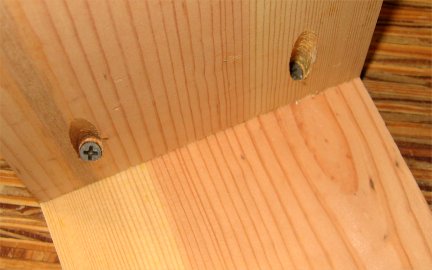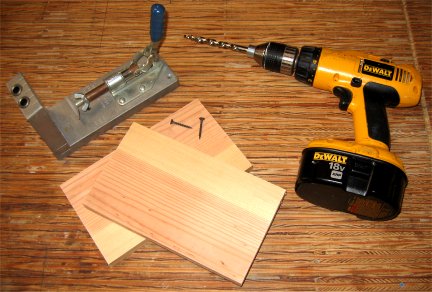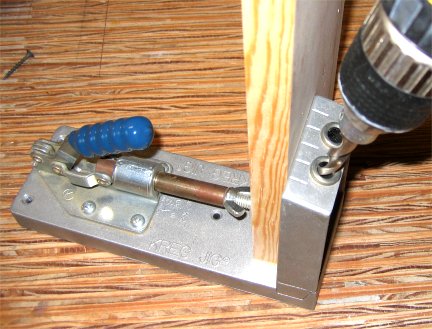

|
<<< Continued from previous page There are, literally, dozens of woodworking techniques to overcome this end-grain problem in perpendicular joints but few that are elegant enough to accomplish without more advanced skills, expensive tools or both - well, with one notable exception: pocket hole joinery. Pocket holes, for the purpose of building bookcases, are holes drilled not into the sides but at an acute angle into the shelves so that a screw can be driven perpendicularly into the grain of the sides:

The beauty of this system is that quickly produces an exceptionally strong and durable joint that requires next to no stock preparation other than cutting side and shelf members to length - i.e., you cut the pieces to length, drill some holes and screw the shelves into place. The process is lightning fast. If you have some sort of saw to make the cuts (or have them cut at your home improvement center) and a power drill, there's only one other gadget you'll need - a Kreg jig:

The shelves are clamped into it like this:

Kreg jigs are typically bundled with a special tapered step drill bit - something you can't do without. Also, these jigs come in all shapes and sizes now, from exceptionally simple and low-cost Harry Handyman models to full-blown production units, sometimes with multiple accessories. You should be able to get something acceptable for under $50, especially if you look for one used on eBay. Do take care to purchase one with an integrated clamp (like the one pictured above). Some of the simpler models require the use of a separate clamp - and believe me, you won't want to mess with them. Woodworker's Supply markets something called the Pock'It Jig kit for $41.99 (plus shipping) that'll work fine. I wasn't able to find this item online, but the print catalog number is 122-381, and it can be ordered 24/7 by calling 1-800-645-9292. Also, special (expensive!) pocket hole screws are manufactured specifically for this purpose, but don't waste your money. If you're using ¾" stock, 1 ¼" drywall screws work great, and they're dirt cheap. In Part III of this series I'll present some bookcase designs for inventory storage.
Want to read more articles by
< to previous article
to next article >
Questions or comments?
| Forum
| Store
| Publications
| BookLinks
| BookSearch
| BookTopics
| Archives
| Advertise
| AboutUs
| ContactUs
| Search Site
| Site Map
| Google Site Map
Store - Specials
| BookHunt
| BookShelf
| Gold Edition & BookThink's Quarterly Market Report
| DomainsForSale
| BookThinker newsletter - free
Copyright 2003-2011 by BookThink LLC
|

|
|